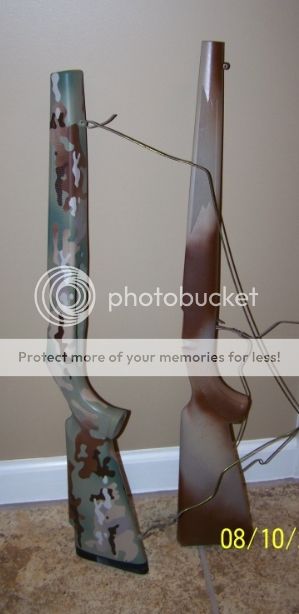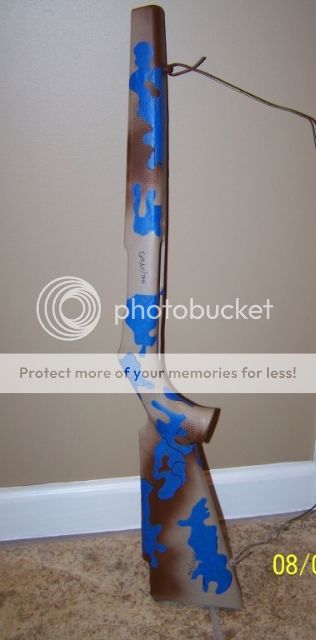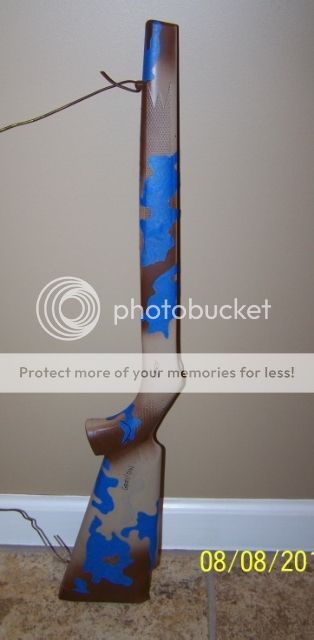Ian
Notorious member
I have a "thing" for the Crye MultiCam(tm) camouflage pattern. Problem is getting the stuff, as they're more protective of their copyrights than Alexander Arms, and trying to purchase small amounts of stuff like fabric or hydrographic film from the very few authorized distributors is difficult or impossible. If one wants to paint it, one must learn how it's done, which I'm here to say ain't easy to get right. I also have a "not thing" for the color black, the color of most AR-15 stuff, or anything "tactical", so I got to learn how to spray paint an AR-15 in what I'm going to call Operational Camouflage Pattern, or loosely, Scorpion W2.
Challenge #1 was discovering just exactly what is "Multicam". Just about every image I found on the internet is different from the next in color scheme, tint, or in some instances the pattern itself. There is the original, much copied Crye pattern, then OCP, and Scorpion W2. The latter two have no "stick" shapes to their pattern, and being less directional, are the ones I chose to emulate for a rifle that might be seen either in a vertical or horizontal position at any given time in the field.
Challenge #2 was finding paint. For one thing, no one can seem to agree on how many or just what the colors for any of these patterns actually are. Some have bright yellow blended with blue-green, some have pink, some grey, some light sage, some actually use a solid OD yellow-green and blend with darker OD. So I just picked one image that matched my existing knock-off brand gear and went searching for paint. I bought 12 cans of spray paint from three different stores and still didn't find quite the shades of green I wanted, so I used four colors dusted over each other to get the two distinct, blended greens needed. What a pain. Next time I do this I will be purchasing Lauer DuraCoat in the correct colors and be done with it.
Challenge #3 was figuring out the pattern. Utoob has a few videos that I watched and tried the methods, but ultimately I found all that pretty much a "fudge" for the real patterns. After experimenting on several objects and two other take-off rifle stocks, I pretty much got it.
So I stripped my Macon Armory DI-45 down to parade rest, degreased it, got all the silicone gun lube out of the pores, prepped the plastic parts (receiver is plastic too), and got busy. I put the base color on last night and started cutting patterns and blending colors on it this morning. Overall I have about 6 hours in painting and about twice that in teardown/prep. I have no idea how much research/testing time I have in it, but it's been my obsession for basically two weeks. Here are some pictures, keep in mind that some of the colors are flat and some satin and that I haven't put the matte clear coat on it yet as the paint will probably need to finish curing for at least a week:
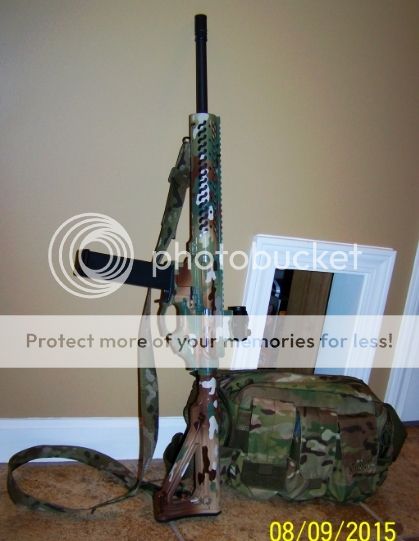
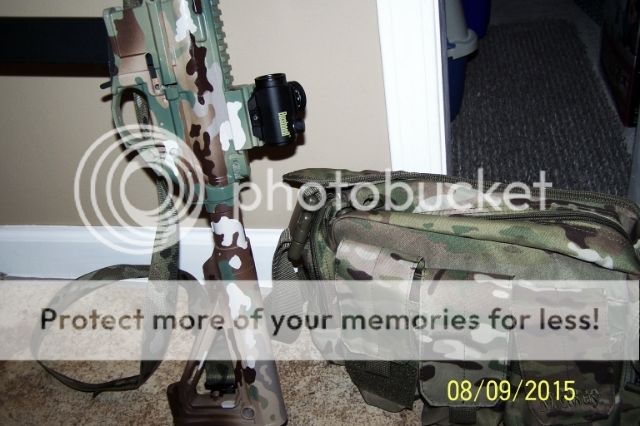
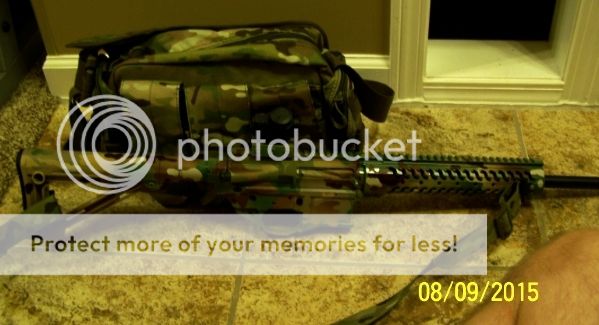
I'll probably put a greenish Magpul MOE hand grip on it to replace the black one I have now. The rubbery stuff doesn't take kindly to paint and I prefer that style grip. The magazines and exposed part of the magwell adapter will get painted too, but I'm leaving the red dot sight, small parts, and barrel alone for now. I tried to work the pattern such that the small parts make up some of the small dark "dots" rather than paint the parts. The dust cover needs painting, but that will have to wait until I catch another wave of enthusiasm, maybe when the magazines get sprayed. I'll try to match the pattern on both sides of the dust cover so it looks right whether open or closed. (Yes, OCD much).
WHEW! I'm tired.
Challenge #1 was discovering just exactly what is "Multicam". Just about every image I found on the internet is different from the next in color scheme, tint, or in some instances the pattern itself. There is the original, much copied Crye pattern, then OCP, and Scorpion W2. The latter two have no "stick" shapes to their pattern, and being less directional, are the ones I chose to emulate for a rifle that might be seen either in a vertical or horizontal position at any given time in the field.
Challenge #2 was finding paint. For one thing, no one can seem to agree on how many or just what the colors for any of these patterns actually are. Some have bright yellow blended with blue-green, some have pink, some grey, some light sage, some actually use a solid OD yellow-green and blend with darker OD. So I just picked one image that matched my existing knock-off brand gear and went searching for paint. I bought 12 cans of spray paint from three different stores and still didn't find quite the shades of green I wanted, so I used four colors dusted over each other to get the two distinct, blended greens needed. What a pain. Next time I do this I will be purchasing Lauer DuraCoat in the correct colors and be done with it.
Challenge #3 was figuring out the pattern. Utoob has a few videos that I watched and tried the methods, but ultimately I found all that pretty much a "fudge" for the real patterns. After experimenting on several objects and two other take-off rifle stocks, I pretty much got it.
So I stripped my Macon Armory DI-45 down to parade rest, degreased it, got all the silicone gun lube out of the pores, prepped the plastic parts (receiver is plastic too), and got busy. I put the base color on last night and started cutting patterns and blending colors on it this morning. Overall I have about 6 hours in painting and about twice that in teardown/prep. I have no idea how much research/testing time I have in it, but it's been my obsession for basically two weeks. Here are some pictures, keep in mind that some of the colors are flat and some satin and that I haven't put the matte clear coat on it yet as the paint will probably need to finish curing for at least a week:



I'll probably put a greenish Magpul MOE hand grip on it to replace the black one I have now. The rubbery stuff doesn't take kindly to paint and I prefer that style grip. The magazines and exposed part of the magwell adapter will get painted too, but I'm leaving the red dot sight, small parts, and barrel alone for now. I tried to work the pattern such that the small parts make up some of the small dark "dots" rather than paint the parts. The dust cover needs painting, but that will have to wait until I catch another wave of enthusiasm, maybe when the magazines get sprayed. I'll try to match the pattern on both sides of the dust cover so it looks right whether open or closed. (Yes, OCD much).
WHEW! I'm tired.

